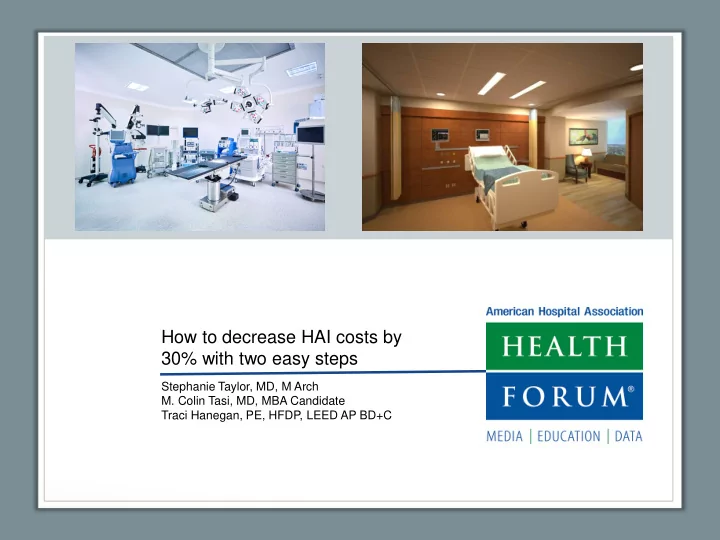

How to decrease HAI costs by 30% with two easy steps Stephanie Taylor, MD, M Arch M. Colin Tasi, MD, MBA Candidate Traci Hanegan, PE, HFDP, LEED AP BD+C
Executive Summary • Impact of reduced operating margins Current healthcare • Emphasis on P4P reimbursement system operational landscape • Current quality efforts and gaps • Pathogen transmission Impact of indoor • Pathogen infectivity environment • Patient defenses • Misconceptions about mold and allergies Barriers to indoor air • Operations and Maintenance management • Effect on costs associated with building energy use • Key steps for hospital leadership Necessary actions • Important considerations during implementation • Potential benefits in financial performance
Despite excess costs, HAIs are alarmingly common and create significant financial burden Total annual HAI cost: $9.8B Annual incidence of 5 most common HAI's in the US* VAP 76,973 UTI 33,482 SSI 158,768 CLABSI VAP $1.85B C Diff 133,806 $3.03B CLABSI 40,381 18.9% 31.6% C. Diff 15.4% Direct hospital cost per HAI case 0.03% $1.51B $45,814 33.7% $40,144 SSI $20,785 $3.30B UTI $11,285 $0.03B $896 CLABSI C Diff SSI UTI VAP Zimlichman E, Henderson D, Tamir O, et al. HAIs: A Meta-analysis of Costs and Financial Impact on the US Health Care System. JAMA *2013 annual volume Intern Med. 2013;173(22):2039-2046. doi:10.1001/jamainternmed.2013.9763 .
To better understand transmission, a 13 month study on indoor air quality, bacterial spread & patient HAIs was performed Monitor indoor Map bacterial conditions in 10 communities in Track patient HAIs patient rooms and 2 these spaces nurse stations Colonization and Succession of Hospital-Associated Microbiota . In Press, Sept 2016 Simon Lax, et.al. U.Chicago, IL 60637
Indoor air RH was found to be the most significant factor associated with patient HAIs Av Avg RH for al all p pat atie ient r rooms Colonization and Succession of Hospital-Associated Microbiota . In Press, Sept 2016 Simon Lax, et.al. U.Chicago, IL 60637
Dry indoor air shrinks aerosolized droplets, promoting pathogen transmission Droplet diameter in microns (um) Float time 0.5 41 hours 1 3 10 1.5 hours 100 6 seconds 10m+ Distance t nce travel elled ed: 1m
Scofield - Sterling diagram published in 1985, with optimal RH level for health of 40%–60%
Viability of many pathogens is reduced in air with RH 40%–60% Humidity above 40% inactivates ≈ 80% of Influenza Viruses within 15 minutes 90 23 80 7 33 70 (%) lity ( 60 irus-Viabili 50 38 40 30 57 Vir 74 43 20 10 0 0 10 20 30 40 50 60 70 80 rel. Hu Humidit ity (%) High Humidity Leads to Loss of Infectious Virus from Simulated Coughs. U. Illinois, 2013 J Noti, et al.
Projected financial impact of room air humidification for a 250-bed hospital
Next steps for healthy humidification in your hospital 1 Record HAIs • Accurately monitor patient adverse events, especially HAIs Monitor indoor air quality throughout the facility 2 • A key starting point is understanding existing indoor RH and how it varies throughout the hospital Identify weaknesses in building envelope and HVAC systems 3 • Look for areas which can be improved • Consult healthcare humidification experts Install appropriate humidification systems 4 • Energy efficient • Hygienic Continue monitoring both indoor air RH and patient outcomes 5 • Assess impact of proper indoor air hydration on patient outcomes and length of stay • Perform ROI analysis
Recommend
More recommend